This post may contain affiliate links. Please see our disclosure policy.
Lime pickles are an old-fashioned type of cucumber pickle that’s made with pickling lime to ensure crisp, fresh-tasting pickles every time. The pickling lime adds crunch to the pickles, and giving them a crisp texture that’s hard to beat!
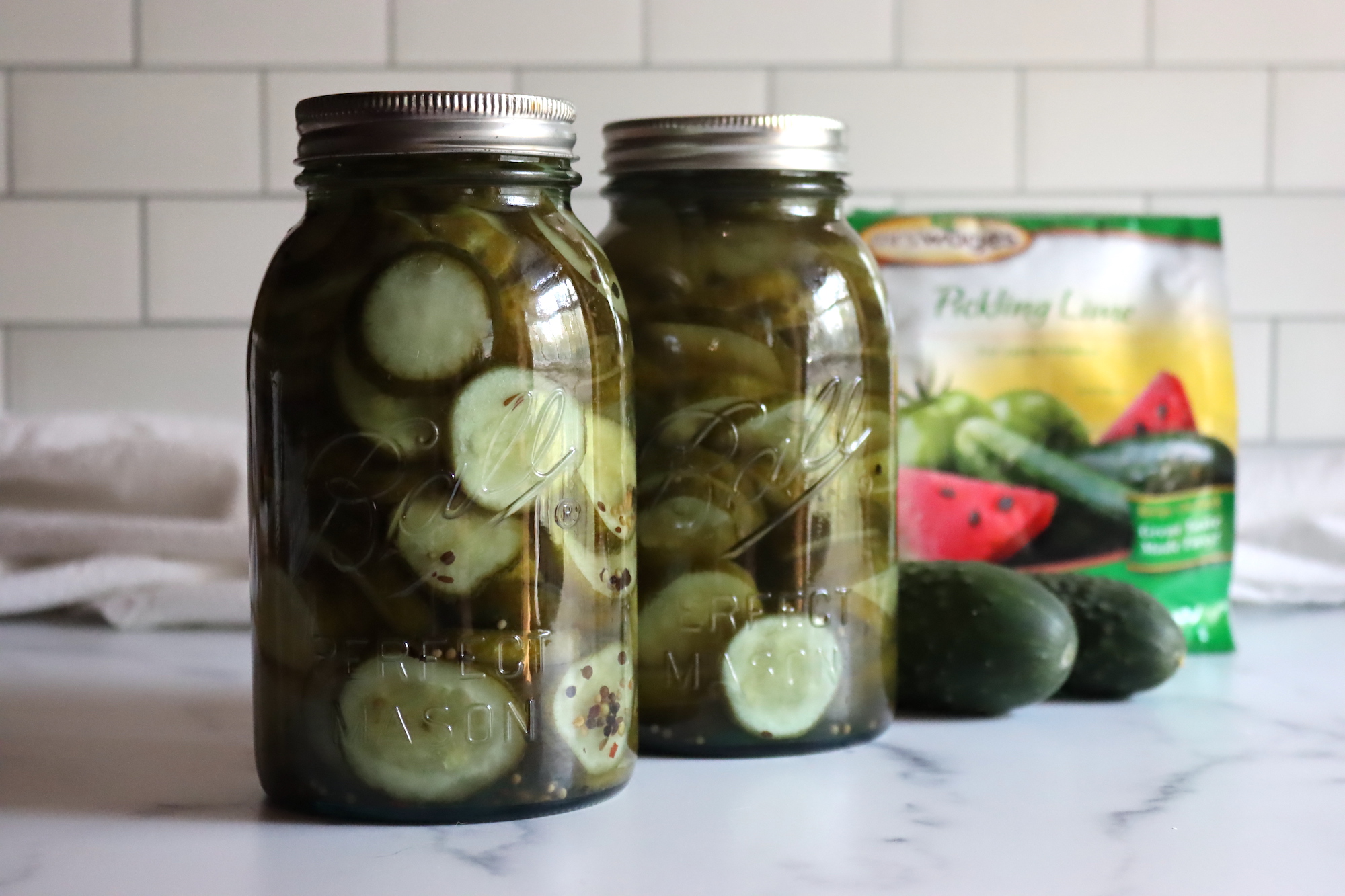
Table of Contents
Do you miss grandma’s old-fashioned pickles, but just can’t seem to find a recipe that’s anywhere near as crisp?
My guess is that she was using pickling lime to firm up the cucumbers before pickling, and there’s nothing that gets them crisp like pickling lime.
Pickling lime is a type of finely ground calcium from limestone, calcium hydroxide, to be precise. Baked, washed, and processed in a special way to ensure its food grade, and in ways that were easy to do back in the pioneer days. (There’s nothing from a modern laboratory in the process, just things that our great-grandparents could do with rocks, kilns, campfires, and kettles.)
Basically, limestone is baked in a kiln, crushed, and then the calcium is extracted in water and then re-dried before being finely ground into a consistent powder. The result is just simple calcium, which helps firm the cell walls of veggies.
Back in the day, pickling lime was a really common ingredient sold at any dry goods store, and it was used in all manner of ways. It will firm just about any vegetable, cucumbers, as others for pickling, but you can also preserve eggs in limewater for more than a year without spoilage.
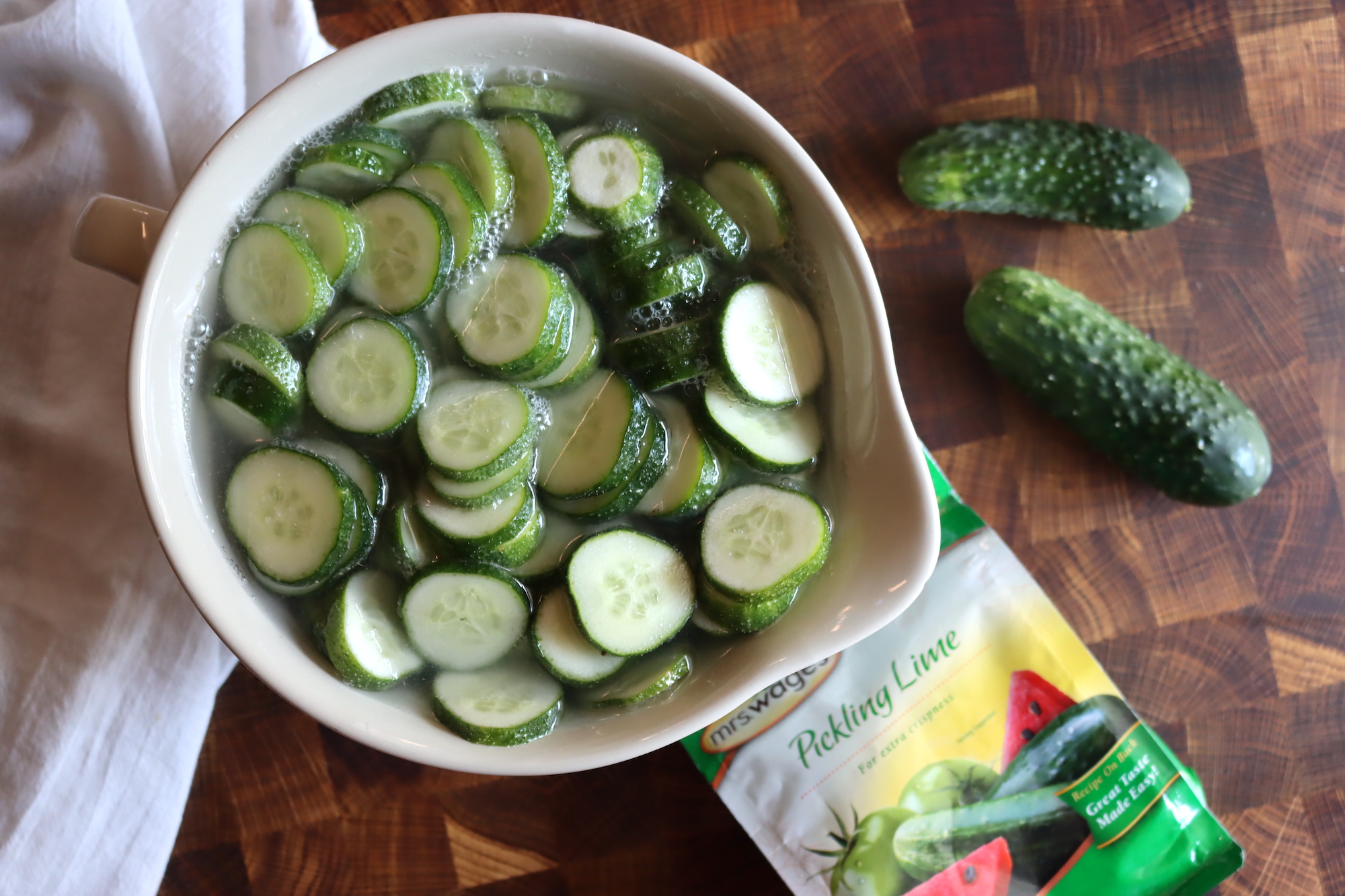
These days, something called “pickle crisp granules“ are sold by Ball Canning and others, and they try to recreate the same thing. In that case, it’s slightly different. It’s calcium hydroxide, and it’s added in a small amount directly to the canning jar.
With pickle crisp, you add 1/8 tsp to each pint of pickles to help firm them up.
With old-fashioned lime pickles, the process takes a bit longer, but the results are much crisper…and it’s hard to find a modern recipe that can compete with these in terms of crunch.

Is Pickling Lime Safe?
Food-grade calcium hydroxide (pickling lime) has been used by cultures around the world as a food additive for millenia, and it’s still used all over the world in traditional recipes. It’s added to cooking pretzels to help them brown, to Chinese century eggs for preservation, and in Mexico, it’s added to corn to make it more digestible (Niximilization).
It’s also sometimes used as a baking soda substitute, especially in traditional recipes from India.
It is perfectly safe to consume, but the question is, are pickles made with it safe to consume? The main issue here is that it’s alkaline, and pickles need to be acidic for preservation.
Here’s what the National Center for Home Food Preservation has to say, as of Fall 2023:
“The calcium in lime definitely improves pickle firmness. Food-grade lime may be used as a lime-water solution for soaking fresh cucumbers 12 to 24 hours before pickling them. Excess lime absorbed by the cucumbers must be removed to make safe pickles. To remove excess lime, drain the lime-water solution, rinse, and then resoak the cucumbers in fresh water for 1 hour. Repeat the rinsing and soaking steps two more times.”
The main thing is that you must really rinse the cucumbers to ensure you’ve removed all of the extra pickling lime from the outside of them before canning. You do want the calcium that’s gone into them to firm up the cell walls, that’s fine, but you just need to make sure that you rinse off the extra that’s coating the outside (and sitting in a slush at the bottom of your soaking bowl).
Recipes using pickling lime also use a stronger pickling brine that most, and they usually involve a 100% vinegar pickling solution (instead of a half water and half vinegar solution). This extra acidity helps ensure the cucumbers pickle properly.
Most pickling recipes that use an all vinegar brine also use a lot of sugar to balance out the acidity from the extra vinegar. That’s why just about every lime pickle recipe is for a type of sweet pickle.
There are other firming agents you can use, such as calcium chloride (sold as pickle crisp and used differently). It works, but not quite as well as pickling lime.
Lastly, there’s Alum (aluminum sulfate), which is no longer recommended as a food additive because it contains aluminum.
According to the National Center for Home Food Preservation, it didn’t work all that well anyway. “Alum may be safely used to firm fermented pickles. However, it is unnecessary and is not included in the recipes in this publication. Alum does not improve the firmness of quick-process pickles.”
Some people still use Alum, and it is still sold as a food additive. The USDA lists it as an approved food additive but not a recommended one. It should be avoided if possible.
Of all the firming agents for pickles, Pickling Lime is the most effective, and perfectly safe if used properly. Pickle crisp is a bit easier to use, but it’s not nearly as effective as pickling lime.
So in summary, yes, it’s safe, but you must remember the following:
- Rinse the cucumbers multiple times after soaking, as the recipe states, to remove all the extra pickling lime
- Use a pickling brine that uses all vinegar as the liquid (at 5% acidity), rather than a brine diluted with water.
Ingredients for Lime Pickles
This recipe comes from the Mrs. Wages New Home Canning Guide (2013), and it’s one of the most commonly used lime pickle recipes. It includes 1 cup of pickling lime dissolved in 2 gallons of water to pickle 7 pounds of cucumbers.
An older version of this same recipe can sometimes be found, and the only difference is that the recipe uses 2 cups of pickling lime. That’s excessive and actually doesn’t really change anything other than having quite a bit of undissolved lime at the bottom of the soaking solution. You can only dissolve so much lime in a gallon of water, and the saturation level is hit a bit before 1/2 cup per gallon. Anything beyond that is just going to sink to the bottom and be wasted.
The ingredients for making about 5 quarts of lime pickles are as follows:
For the Pre-Soak
- 7 lbs Pickling Cucumbers, 3-4 inches long (about 40)
- 1 cup Pickling Lime
- 2 Gallons Water, plus more to rinse
Pickling Brine
- 8 Cups White Vinegar (5% Acidity)
- 8 Cups Sugar
- 1 Tbsp Canning Salt
- 1 Tbsp Pickling Spice
You’ll note that there’s no water in the pickling brine, and that’s intentional. Generally, in pickling recipes, you’re allowed to use up to 50% water as liquid for less tart pickles, so long as the brine is at least 50% vinegar at 5% acidity. With lime pickles, you really need the extra acidity because calcium in lime is basic, and needs extra vinegar to get the right finished pH in the pickles.
That’s one reason lime pickles are pretty much always sweet pickles. You’re using twice as much vinegar as you would in your average dill pickle recipe, so you need to use more sugar so they’re not too sour. With a 1:1 ratio of sugar to vinegar, these pickles come out quite sweet, but old-fashioned pickles were often quite sweet, unless they were crock fermented sour pickles.
If you don’t like sweet pickles, you can reduce the sugar, as it’s added for flavor rather than preservation. Do not reduce the vinegar, though, all the liquid in the pickling brine must be vinegar for preservation.
Also, be sure that you don’t skip any of the steps in the recipe, namely the rinsing and extra rinsing to remove the extra lime, then soaking the cucumber in the brine, as well as boiling the brine (without the cucumber in it) for 35 minutes. That re-concentrates the brine further after it’s been diluted by the water in the cucumbers from the brine soak.
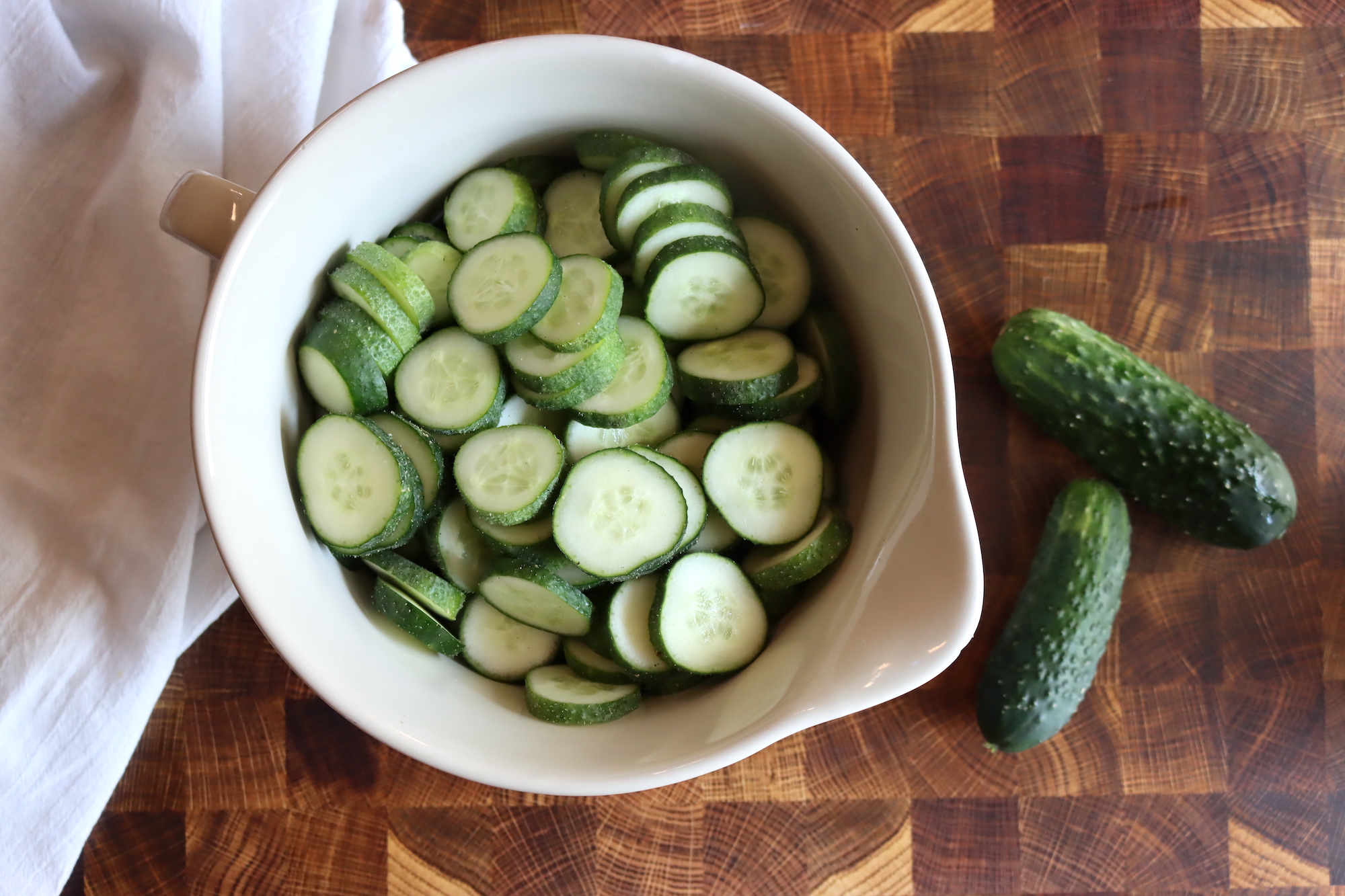
How to Make Lime Pickles
Making lime pickles is more about the process than anything else. The total time is a few days, when you include the soaking steps, but most of the work is hands-off as things soak.
Start by washing the cucumbers and giving them a gentle scrub to remove their spines.
Next, trim about 1/8 to 1/16 of an inch off the blossom end of each cucumber and discard. The blossom end contains an enzyme that softens pickles in the canning jars, so that needs to be discarded.
Slice the cucumbers into convenient slices, about 1/4 inch thick. You cannot make whole pickled cucumbers when using lime, as it takes too long for the brine to get to the center of the cucumber, and they may spoil before they’re properly pickled. The lime also crisps the outside of the cucumber at the skin, and prevents the brine from getting through to the center. That’s true even with very small cucumbers. They must be sliced.
You can, however, make pickle spears by cutting the cucumbers into quarters vertically or “sandwich slabs” by slicing the cucumbers into 1/4 inch slices vertically so that they’re long slices. The most common preparation, however, was simple cucumber slices, so that’s what I’ve done here.
Place the cucumber slices into a large, non-reactive food-grade container. Do not use anything containing aluminum or other reactive metals like copper, as that will react with the lime (ruining both the container and the pickles). Make the lime solution by stirring 1 cup of pickling lime with 2 gallons of water and then pouring over the cucumber slices.
Be sure that they’re completely submerged. A plate with a weight on top can help keep them submerged.
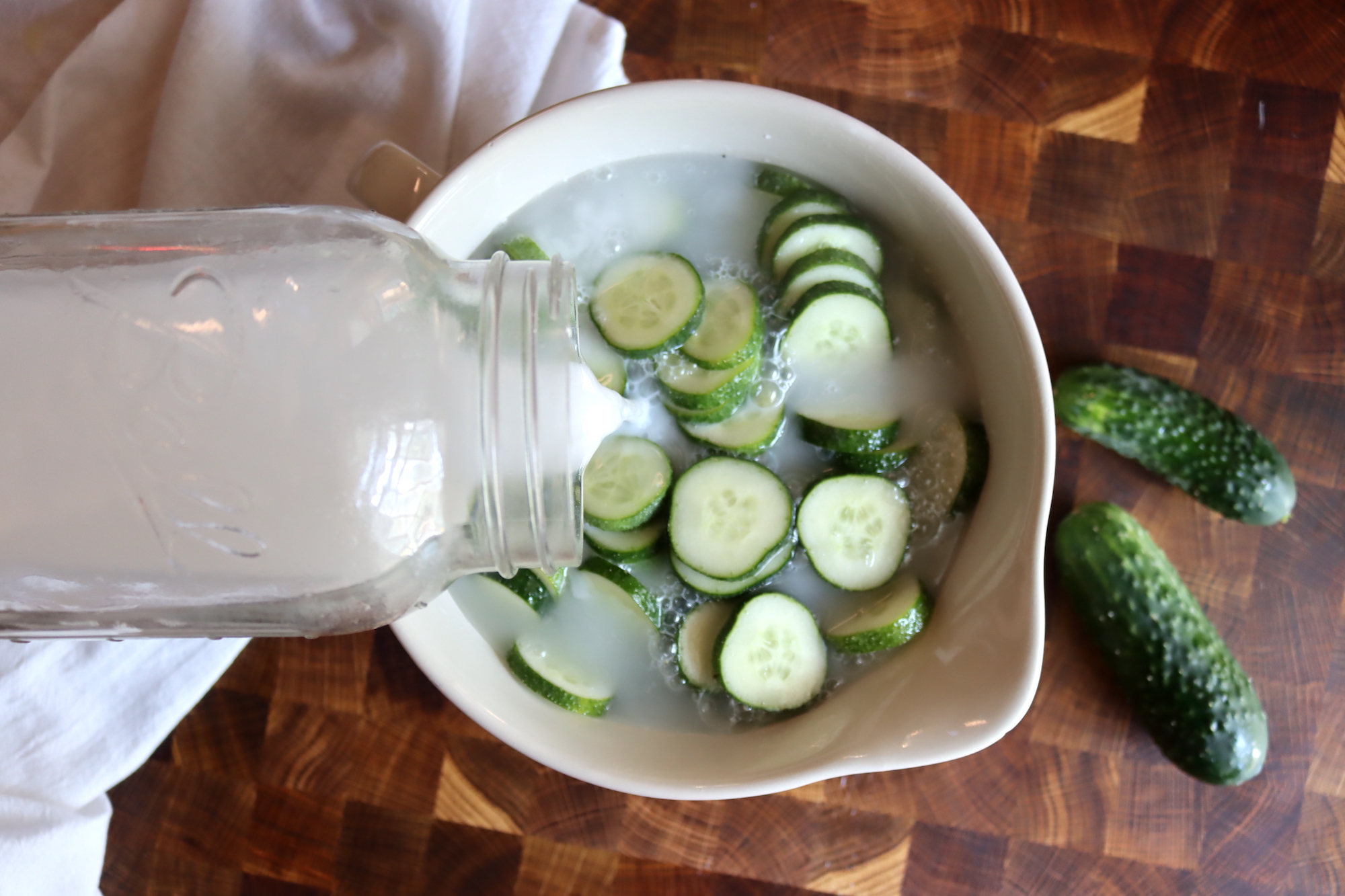
Soak the cucumbers in the lime solution for 12-24 hours, stirring occasionally.
During the soaking process, you may see some bubbles coming up from the cucumbers. They’re not fermenting, and this is not a fermented cucumber recipe, but they are losing air from their tissues. This will help them stay firm in the canning jars, and not float once canned.
After the soak, drain the lime solution and discard. (It’s fine for pouring down the sink, but it’s also good for gardens and compost, especially if you have acidic soil.)
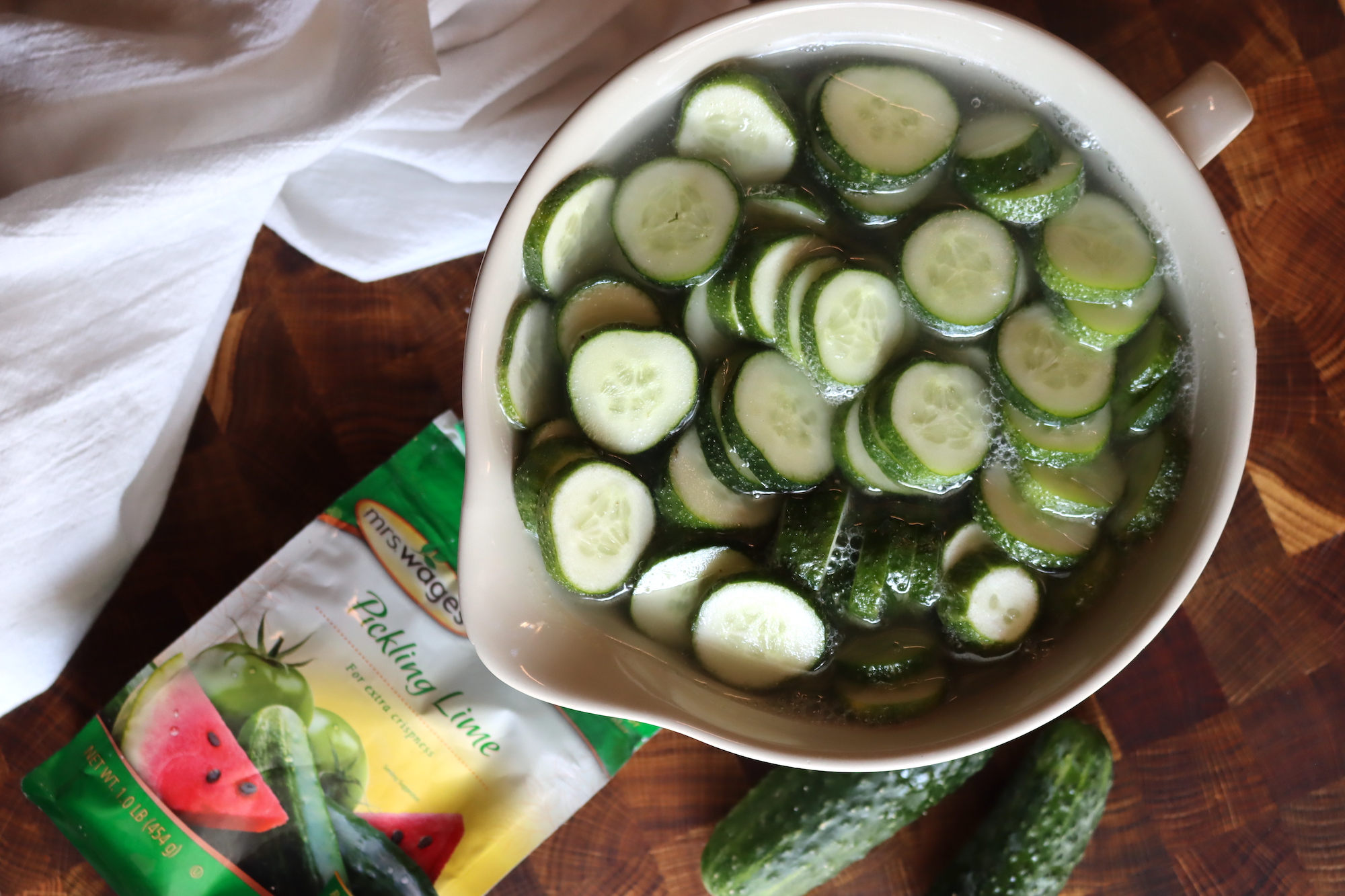
Rinse the cucumbers at least 3 times to remove all the lime from their surfaces. Next, place the slices in a clean container and soak in ice water for 3 to 6 hours.
This chills the cucumbers, which helps firm them, but it also soaks out the last bit of extra lime.
Removing all the extra lime is incredibly important for safety, as the lime solution is basic, and the pickling brine needs to be acidic to preserve the pickles. Any extra pickling lime solution or dissolved lime left on the outside of the pickles could cause spoilage. Do not skip the soaking process!
Once the cucumbers have soaked that final time, drain the liquid and give them one final rinse.
Prepare the pickling brine by mixing the vinegar, sugar, salt, and spices together. Do not heat the brine at this point, just stir it really well to try to dissolve it as best you can. (Alternately, bring it to a boil to dissolve everything, but then allow it to cool completely.)
Pour the room temperature or cool brine over the cucumbers and allow them to soak in the brine in the refrigerator for about 6 hours, or overnight.
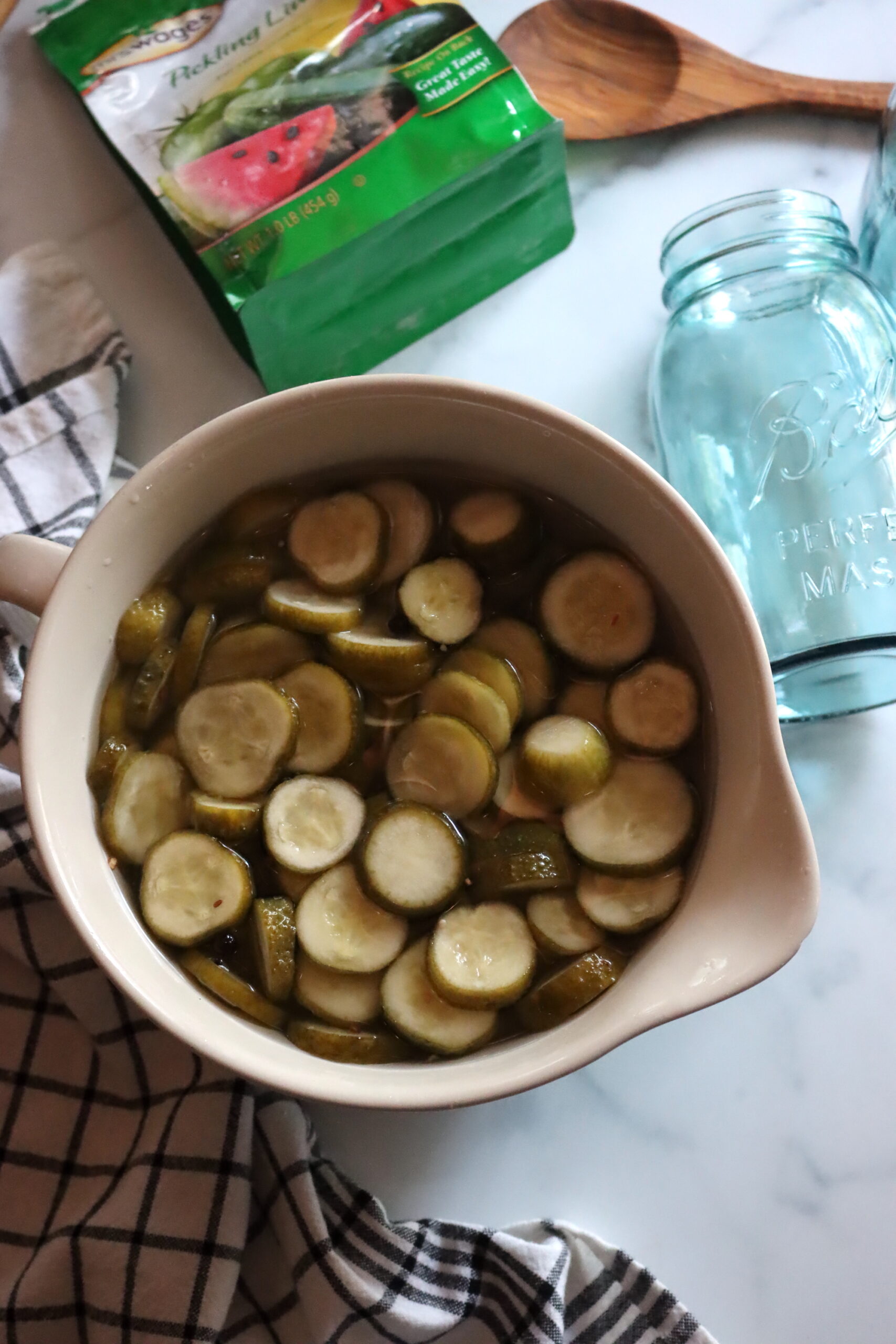
This does a few things…
First, it pulls water out of the cucumber slices by osmosis, which helps prevent them from being soggy and crisps them further. Second, it starts to acidify the cucumber slices before canning, which ensures that the brine penetrates fully into the cucumbers for preservation.
After the soak, drain the brine into a stock pot, reserving the soaked cucumbers to the side.
Bring the brine to a hard boil, and then turn it down to a simmer. Simmer the brine for 35 minutes.
This concentrates the brine, and drives off the water that came out of the cucumbers in the soaking process.
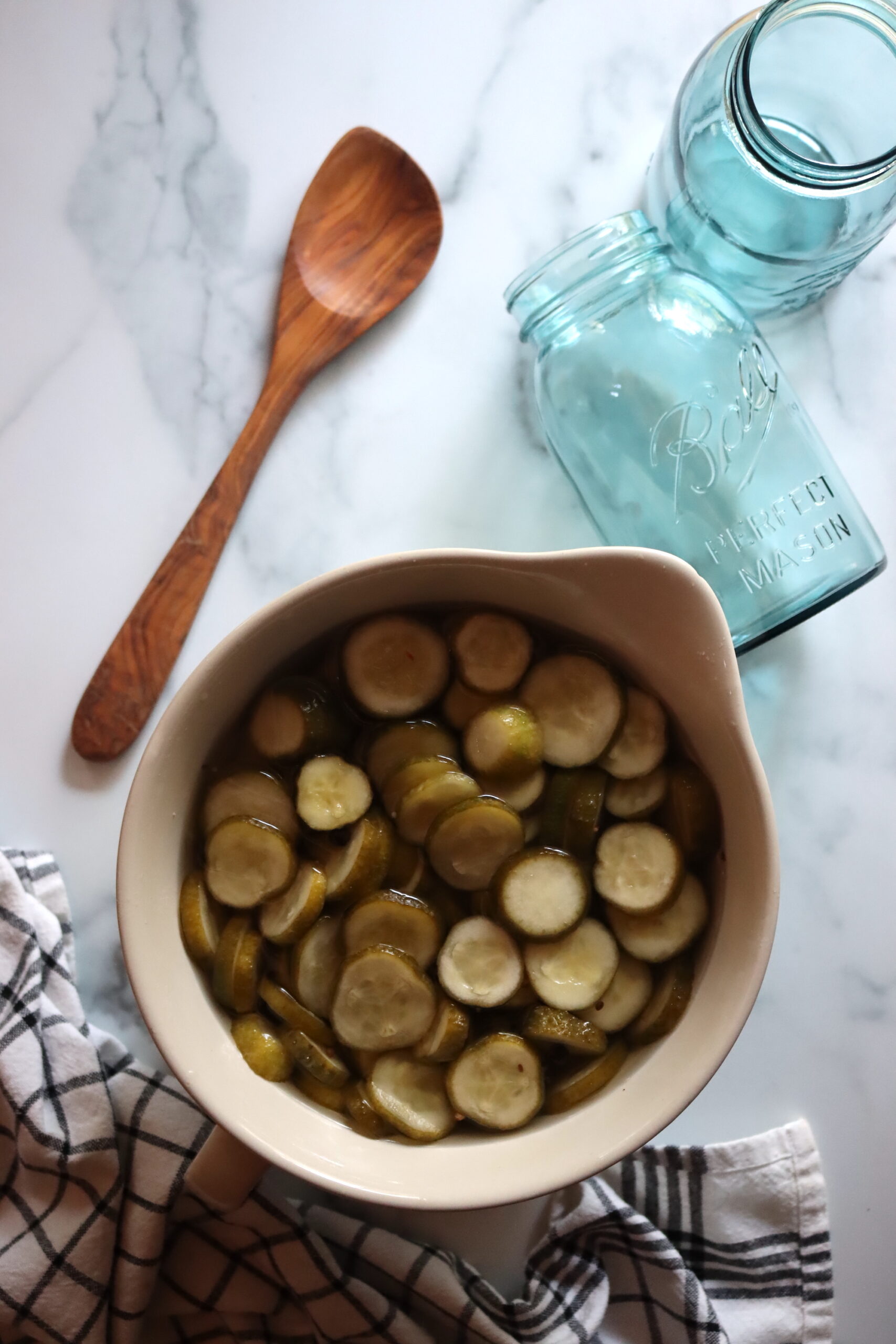
Canning Lime Pickles
At this point, if you’re canning, it’s time to prepare a water bath canner. These do not have to be canned, and they can be stored in the refrigerator as fridge pickles for use within a few months. That said, canning ensures that they’ll keep all year, and that’s my preference. The point of the lime is to crisp them so they’ll stay firm through the canning process, and if you’re not canning, you can just make quick refrigerator pickles with raw cucumbers.
While the brine is simmering, prepare a water bath canner and jars. The canner should be pre-heated to about 180 degrees F for hot pack canning. The jars should be warmed, and the lids and rings prepared.
Pack the cucumber slices into prepared jars, leaving 1/2 inch headspace. They will shrink a bit in canning, so they can be packed tightly.
Turn up the heat on the brine and bring it back to a hard boil. Pour the boiling brine over the cucumber slices in the jars. De-bubble jars and adjust headspace to maintain 1/2 inch.
Cap with 2-part canning lids and load the jars into the pre-heated water bath canner.
Bring the canner to a full rolling boil and process pint jars for 10 minutes, quart jars for 15 minutes, adjusting for altitude (see below).
Once the canning time is complete, turn off the heat and allow the pickles to sit for another 5 minutes before removing them to cool completely on a towel on the counter. This extra 5 minutes helps prevent thermal shock ont he jars and siphoning or liquid loss as you remove the jars.
Once completely cool, check seals and store any unsealed jars in the refrigerator for short-term use. Properly canned and sealed jars of lime pickles will maintain peak quality on the pantry shelf for 12-18 months and be safe to eat as long as they’re sealed. Refrigerate after opening.
Be sure to wait at least 2 weeks for the spices and vinegar to pickle the cucumbers properly before eating. (They’re ok after about 2 days, but best after about 2 weeks.)
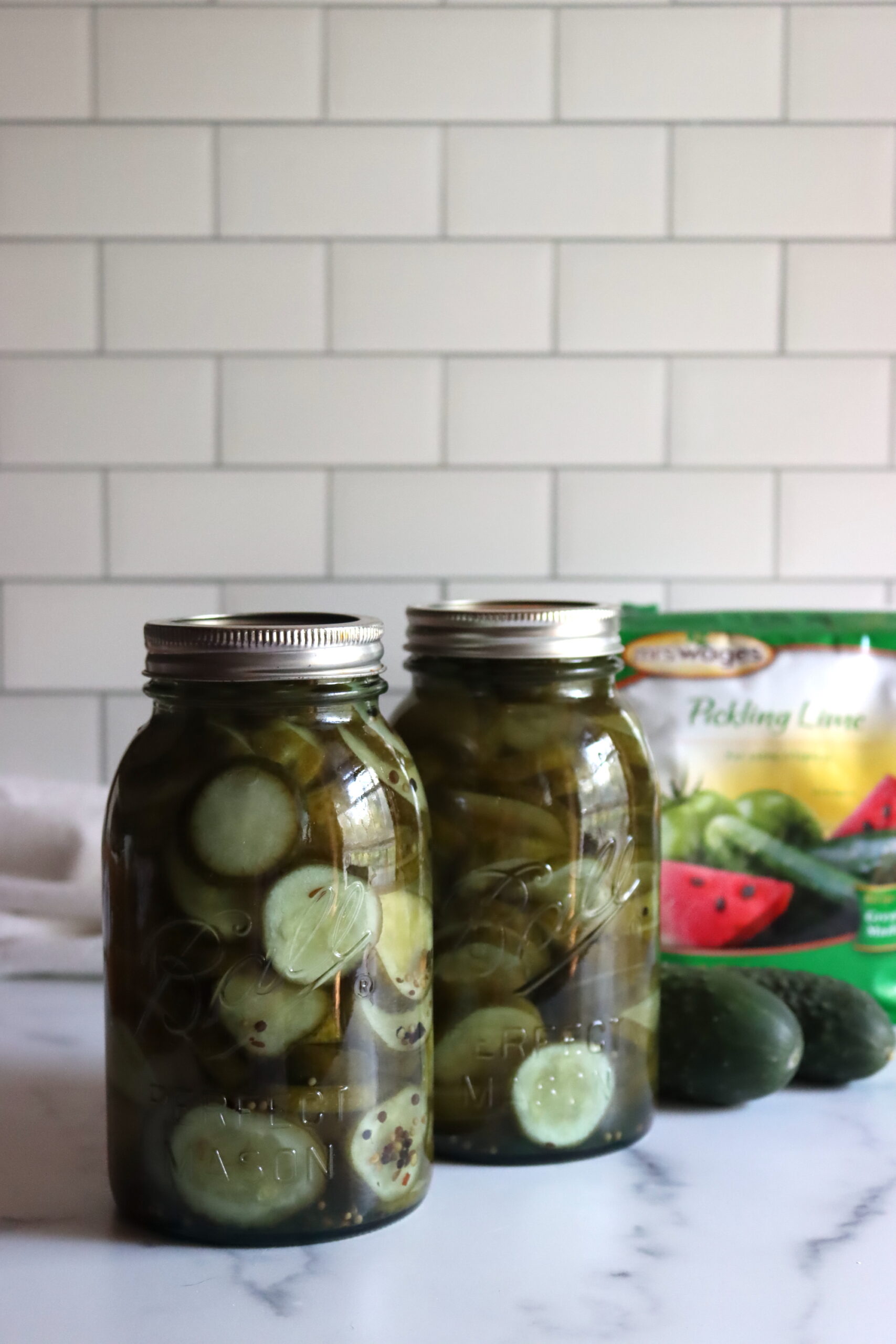
Altitude Adjustments for Canning Lime Pickles
If you’re under 1,000 feet in elevation, the processing times for lime pickles are 10 minutes for pint jars and 15 minutes for quart jars. Above 1,000 feet, the times are as follows:
- For 1,001 to 3,000 feet – Use 15 minutes for pints and 20 minutes for quarts
- For 3,001 to 6,000 feet – Use 20 minutes for pints and 25 minutes for quarts
- Above 6,000 feet – Use 25 minutes for pints and 30 minutes for quarts
Lime Pickle Variations
What I’ve written here is an old-fashioned sweet lime pickles recipe, and it’s probably the most common lime pickle recipe anywhere. That said, you can make lime pickles a number of ways, and they don’t all involve cucumbers. The National Center for Home Food Preservation has a number of tested lime pickle recipes, for cucumber pickles like bread and butters, of course, but also for Jalapenos, which really benefit from lime treatment before pickling.
Be sure to follow the recipe very closely, as you would with any canning recipe, and rinse thoroughly to remove all the extra lime before pickling.
- Bread and Butters with Pickling Lime
- Sweet Pickles with Pickling Lime
- Pickled Jalapenos with Pickling Lime
The soaking and preparation process is more or less the same with these recipes, the only difference is they’re finished with a different spice mix in the pickling brine, creating a different flavor…but preserving the same crunch as with this lime pickle recipe.
(The jars used in this article are quart-sized Ball Aqua Vintage Mason Jars, which are a modern canning jar made to look like the stunning blue glass vintage jars made in the period between 1910 and 1923. I thought they were particularly appropriate to this old-fashioned lime pickle recipe.)

Old Fashioned Cucumber Lime Pickles (with Pickling Lime)
Ingredients
For the Pre-Soak
- 7 lbs Pickling Cucumbers, 3-4 inches long (about 40)
- 1 cup Pickling Lime
- 2 Gallons Water, plus more to rinse
Pickling Brine
- 8 Cups White Vinegar, 5% Acidity
- 8 Cups Sugar
- 1 Tbsp Canning Salt
- 1 Tbsp Pickling Spice
Instructions
- Wash and scrub the pickling cucumbers, and then remove the stems and cut off the blossom ends.
- Slice cucumbers into 1/4 inch (or thinner) slices.
- Mix the pickling lime in water to create a soaking solution.
- Place the cucumber slices into a non-reactive container (glass, ceramic, stainless steel, plastic, etc.). Avoid aluminum or copper containers, as the lime will react with the container, ruining the container and the pickles.
- Pour the pickling lime solution over the cucumber slices, and weigh them down with a plate to ensure they're completely submerged.
- Soak the cucumbers for about 12 hours, or overnight. Stir occasionally, if possible, to keep the lime evenly distributed in the water.
- After the soak, pour off the soaking water and discard. Rinse the cucumbers 3 times in clean water, making sure that you remove all the lime from their surfaces and the container.
- Soak the cucumber slices in clean ice water for 3 hours to chill them and remove any last bits of extra pickling lime.
- Drain and discard the soaking water.
- Prepare a pickling brine by mixing the brine ingredients (vinegar, sugar, etc). Unlike other pickling recipes, the brine should be room temperature at this point.
- Pour the room-temperature brine over the prepared cucumber slices and let them stand for about 6 hours, or overnight. Cover to keep out pests, and refrigerate if possible.
- After the brine soak, drain the brine into a stock pot (straining out the cucumber slices for now) and bring it to a boil. Turn the heat down to a simmer and simmer the brine (without the cucumbers) for 35 minutes.
- While the brine is simmering, prepare a water bath canner by pre-heating it for raw pack (about 140 degrees F) and also prepare jars, lids and rings.
- Pack the cucumber slices into prepared jars. They can be packed quite tightly as they'll shrink during canning. Be sure to leave 1/2 inch headspace.
- Once the brine has simmered for 35 minutes, pour the brine over the top of the cucumber slices in the jars, maintaining 1/2 inch headspace.
- Debubble the jars, adjust headspace, and seal with 2-part canning lids to finger tight. Load the jars into the pre-heated canner.
- Bring the canner up to a full rolling boil, and when boiling, process the jars for 10 minutes (for pints) or 15 minutes (for quarts), adjusting for altitude.
- After canning, allow the jars to cool on a towel on the counter to room temperature and check seals. Store any unsealed jars in the refrigerator for short term use, but sealed jars can be stored on the pantry shelf.
- Properly canned and sealed jars will maintain peak quality for 12 to 18 months, and be safe to eat so long as they're sealed. Refrigerate after opening. Allow at least 2-3 days after processing before tasting to allow the cucumbers to properly pickle. They'll be best after 2 weeks.
Notes
Altitude Adjustments for Canning Lime Pickles
If you're under 1,000 feet in elevation, the processing times for lime pickles are 10 minutes for pint jars and 15 minutes for quart jars. Above 1,000 feet, the times are as follows:- For 1,001 to 3,000 feet – Use 15 minutes for pints and 20 minutes for quarts
- For 3,001 to 6,000 feet – Use 20 minutes for pints and 25 minutes for quarts
- Above 6,000 feet – Use 25 minutes for pints and 30 minutes for quarts
Nutrition
Nutrition information is automatically calculated, so should only be used as an approximation.
Cleaning Up Pickling Lime
Small amounts of pickling lime are perfectly fine for disposing of down your regular kitchen sink, whether it goes to a septic tank or regular sewer. This type of lime is sometimes even used in water treatment facilities for treating public water supplies, so it’s possible it may already be in your water in small amounts.
If you have a drain pump system that pumps water from a basement drain to a drain pipe overhead, as exists in some basement kitchens, then avoid washing lime down the drain as it can mess with the pumping mechanism. Instead, just dump it outside on your lawn or garden (as it’s also used in gardens as a fertilizer, especially on acidic soils).
Sometimes, lime can form a film on your kitchen tools, and in that case, just wipe it off with a vinegar-soaked towel. Vinegar will remove limescale from dishes and surfaces.
Pickling Recipes
Looking for more simple pickling recipes?
- Pickled Corn Salad
- Pickled Three Bean Salad
- Pickled Green Tomatoes
- Pickled Green Beans (Dilly Beans)
- Pickled Jalapenos
- Pickled Fiddleheads
Summer Canning Recipes
Keep your canning pantry full with these summer canning recipes!
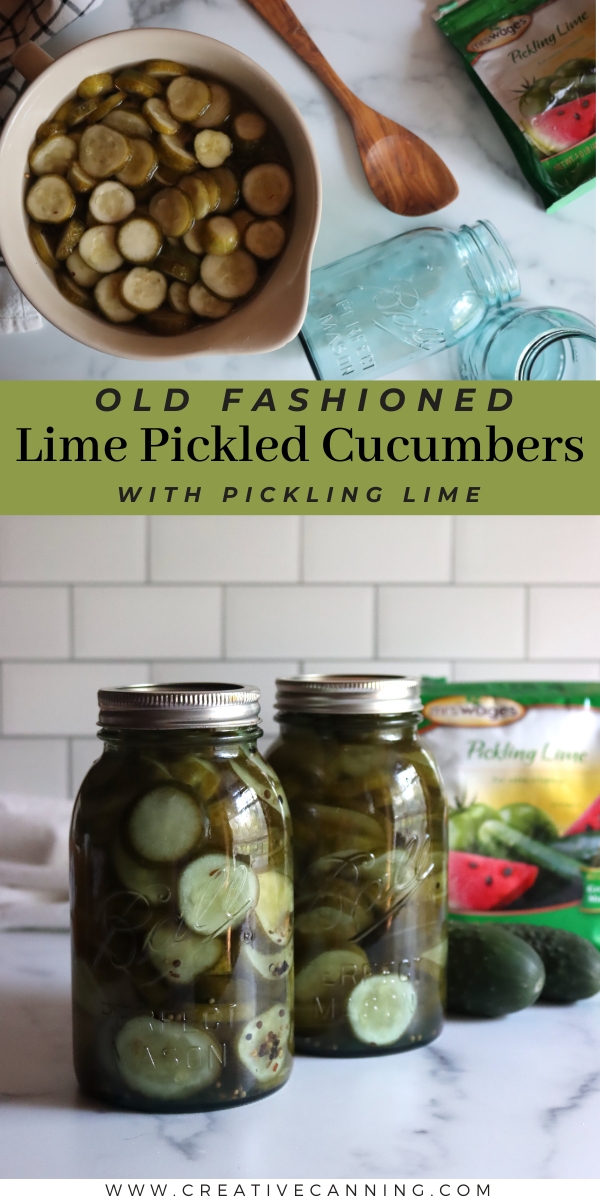
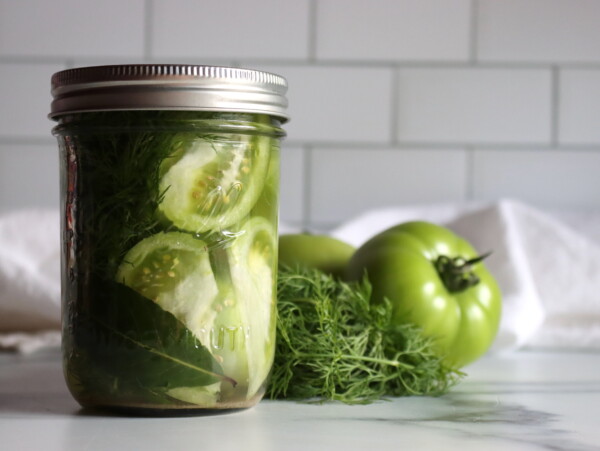
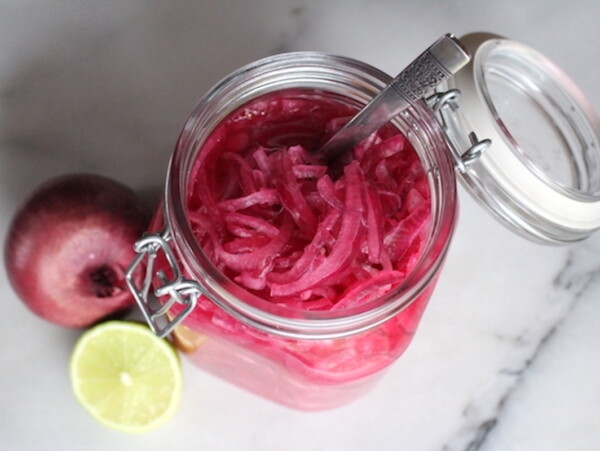
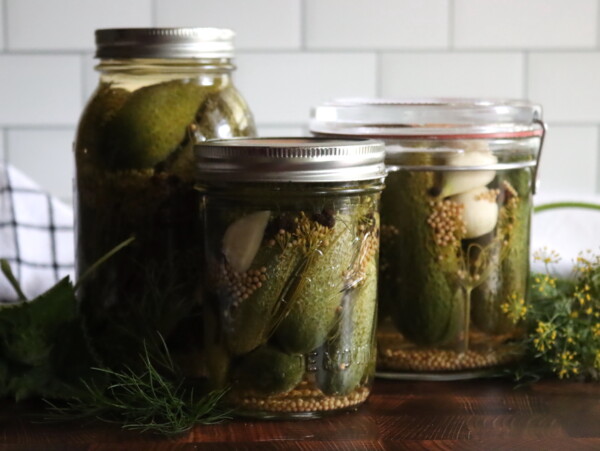

Super crunchy pickles, very good. My Dad loves them. Thanks’ so much.
O. M. G. When I was a college freshman, my boyfriend’s father made lime pickles. I had never had them before, but I fell in love with them. I tried a recipe a few years ago and they were horrible. I found your recipe and it is EXACTLY as I remember them! And, they are crunchy! I was worried about the sweetness due to the amount of sugar, but they are not overly sweet at all. Thank you!
Wonderful! I’m so glad you enjoyed them!
Oops. I already soaked whole gherkins in lime overnight. Should have read your piece first. What to do now?
If you soaked the cucumbers whole, you can just process them as whole pickles. This recipe is for whole lime pickles: https://www.mrswages.com/recipes/old-south-cucumber-lime-pickles/
Ashley, This pickle recipe is exactly what was looking for. Thank you for sharing. These are delicious!!!!
Jayne F.
Wonderful, so glad you enjoyed them!
Ashley,
Thank you for this old fashioned recipe. I made it years ago, but did not know it was still safe to use. I especially liked the historical background information. I haven’t made the recipe yet, as cucumbers are just coming on in the garden. I am sure it will be good.
Thank you for your truly “creative” recipes. They make canning more interesting after many years of canning. I made apricot bbq sauce and old fashioned raspberry jam yesterday, and will make apricot salsa today.
Have a great day!
Nice! I really loved that apricot salsa, it came out so good!
This was such an informative read! I appreciate how you make learning feel like a conversation rather than a lecture.
Thanks Kieth!
would english cucumbers work as i cannot find any pickling cucumbers in my area right now
You can use English cucumbers and the recipe will still work. They’re often a bit less firm, but the lime actually should counteract that.
PIckle crisp granules are not calcium hydroxide — as you say — but rather, calcium chloride. Pickling lime is calcium hydroxide. Best make a correction.